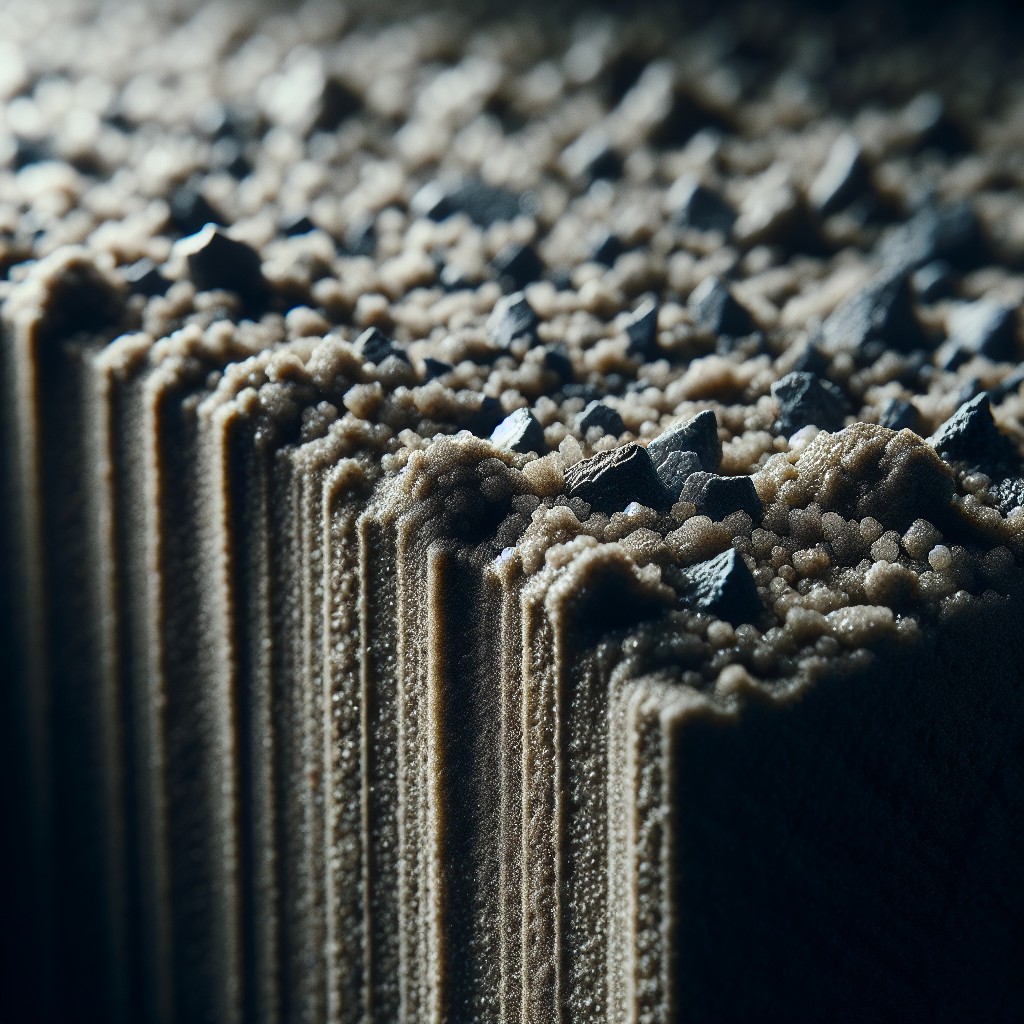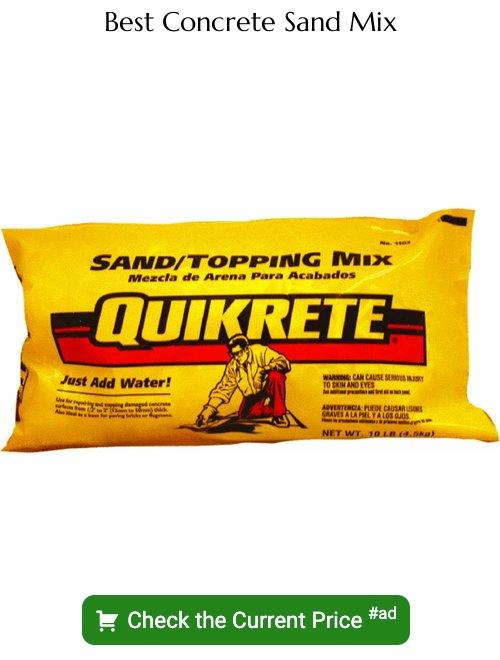Last updated on
Unravel the mysteries of concrete sand, because understanding its essential role can transform your construction project outcomes.
Key takeaways:
- Concrete sand has a coarse texture and larger grains than regular sand.
- It enhances the structural integrity of concrete and reduces voids.
- Concrete sand is composed primarily of crushed quartz and granite.
- The grain size and texture of concrete sand affect its workability and durability.
- It is available in gray and tan, offering aesthetic versatility.
Definition of Concrete Sand

Concrete sand is a key ingredient in the creation of concrete. It’s a particular type of sand with a coarse texture and larger grains than regular sand, which contributes to the strength and durability of concrete.
This sand is made primarily from crushed quartz and granite, making it perfect for use in construction due to its rough texture and consistency. Its unique properties help to bind other components together, promoting a firm and stable concrete mix that can withstand various environmental factors.
This specific sand not only enhances the concrete’s structural integrity but also minimizes voids in the mixture, resulting in a higher-quality final product that’s essential for a myriad of construction projects.
Importance in Concrete Mix

Concrete sand serves as a staple in the creation of cement-based mixtures due to its coarse texture which enhances the strength and durability of the finished product.
Its unique characteristics facilitate optimal binding of concrete components, contributing to the structural integrity of buildings and infrastructure.
By introducing gaps among particles, concrete sand ensures a well-graded mix that allows for the even distribution of cement and reduces shrinkage and cracking upon setting.
Moreover, it aids water drainage and prevents excessive denseness in the mix which can lead to issues in workability during application.
Its balanced granule size enhances the overall durability and finish of the concrete, making it indispensable in high-quality construction projects.
Composition and Properties
Composed primarily of silica, calcium carbonate, and a blend of other minerals, concrete sand offers a balance between stability and workability. Its grains are typically sharper and more angular compared to beach or play sand, resulting in a more effective binder in the concrete mix due to the interlocking of particles. The rough texture contributes to a stronger bond in concrete projects.
With a consistency that prevents clumping and improves compaction, concrete sand has an optimal moisture content and plasticity that aids in creating a durable finished product. As a natural material, its gradation, color, and chemical properties can vary slightly based on the source quarry, yet it consistently meets industry standards for construction use.
Grain Size and Texture
Understanding the precise characteristics of grain size and texture is essential in determining the suitability of sand for concrete applications. Ideal concrete sand should have grains that are coarse enough to bind well with the cement paste, yet fine enough to fill the gaps between the aggregate effectively.
First, consider that the grains should be uniformly sized; too wide a distribution can lead to weak concrete, as the smaller particles can fill spaces intended for the larger grains, disrupting the concrete’s internal structure. A well-graded sand creates a denser, more cohesive mix.
The texture of the sand grains plays a significant role as well. Rougher grains improve the bond to the cement paste, enhancing the strength of the final product. However, overly coarse sand can make the mix more challenging to work with.
A balanced grain size and texture contribute to the workability of the concrete, its durability, and its ability to resist compression. The right combination reduces voids in the concrete, making it less permeable and better able to withstand the elements. For structural applications, consistently achieving this balance is paramount for long-term stability and integrity.
Concrete Sand Vs. Other Sands
Understanding the nuances between concrete sand and other types of sand is crucial for optimal construction outcomes. Here’s how concrete sand stands apart:
1. Particle Size and Shape: Concrete sand features larger, coarser grains and a more angular shape than play sand or masonry sand, which typically exhibit finer and rounder grains. This angularity enhances the binding properties in concrete.
2. Purity Level: This sand is free from salts and organic impurities that can be found in beach or river sand, ensuring it doesn’t affect the setting time and strength of concrete.
3. Versatility in Usage: While other sands may serve specific purposes, such as fill sand for backfilling or utility sand for pipe bedding, concrete sand is a jack-of-all-trades in construction, adept for use in concrete, paving, and bedding alike.
4. Compliance with Standards: It aligns with ASTM C33 specifications, the standard for quality in concrete aggregates, which not all sand types meet.
By choosing concrete sand for its intended applications, you ensure a structurally sound and lasting end product.
Benefits in Construction
Concrete sand plays a pivotal role in ensuring the durability and longevity of structures. Its coarse texture enhances the binding properties of concrete, which directly contributes to the stability and strength of the finished product.
When mixed with cement and water, the sand fills voids between aggregate pieces, reducing the possibility of air pockets and weak spots. Furthermore, the resistance to erosion and physical wear makes this material ideal for high-traffic areas and surfaces subjected to environmental elements.
It also contributes to the overall workability of the concrete mix, allowing for smoother application and shaping, which is critical in both large construction projects and smaller, detailed work.
Calculate Tonnage
When planning a project, knowing the amount of concrete sand needed is crucial. Calculating tonnage involves a simple formula: length (in feet) x width x depth (both in inches) divided by 12, then divided by 27, gives you cubic yards. To convert cubic yards to tons, multiply by the material’s weight per cubic yard – concrete sand typically weighs about 1.3 tons per yard. For irregularly shaped areas, divide the space into smaller rectangles and calculate each section before adding them up. Precision in these calculations ensures you purchase the right amount, avoiding waste and additional costs. Keep in mind, moisture content can slightly alter the weight of the sand, hence affecting the tonnage. Always round up to the nearest quarter yard to account for variations when placing your order.
Finding Coverage Per Ton
Understanding coverage per ton is crucial when planning your project to ensure you purchase the right amount of concrete sand. Here’s what to keep in mind:
- Area Calculation: Begin by determining the square footage of the area you’re covering. Multiply the length by the width.
- Depth Requirement: Establish the desired depth for your concrete sand layer, typically measured in inches.
- Cubic Yardage: Convert your area and depth into cubic yards, as sand is often sold by the cubic yard. One ton of sand generally covers about 100 square feet at 2 inches deep.
- Tonnage Conversion: Be aware that coverage can vary based on sand moisture and compaction. As a general rule, one cubic yard equals approximately 1.25 tons.
- Professional Advice: When in doubt, consult with a professional about specifics relative to your project for the most accurate estimation.
Remember, it’s wise to purchase a bit extra to accommodate for settlement and compaction over time, ensuring your project maintains its integrity.
Delivery Options
When you’ve decided on the ideal concrete sand for your project, the next step is sorting out how it gets to you. For small-scale DIY jobs, purchasing bags from your local hardware store is feasible, and you can transport them in a standard vehicle. However, large-scale projects require bulk delivery, which opens up a few options:
1. Local Delivery Services: Many suppliers offer delivery services with the purchase of bulk sand. The cost often depends on the distance from the supplier to your site.
2. Dump Truck Hauling: A common method for large quantities is delivery via dump trucks. Depending on the size of the project, trucks can range from small ones capable of carrying 1 ton, to larger ones that can handle up to 25 tons.
3. Tilt Trailers and Flatbeds: These are suitable for sites with limited space or where it’s necessary to drop the sand at multiple locations.
4. Self-Pickup: If you have access to a heavy-duty truck and want to save on delivery costs, self-pickup might be a viable alternative. Ensure your vehicle can handle the weight and the supplier has the equipment to load your truck safely.
5. Pneumatic Tankers: For extremely large projects or specialized concrete mixes, bulk sand can be delivered in pneumatic tankers that blow the sand directly into a storage silo.
Connect with your supplier beforehand to discuss the best delivery method for your needs, and always check local traffic regulations regarding heavy load transport to ensure a smooth delivery process.
Purchase Points and Easy Ordering
Selecting the right supplier is key to streamline your construction project’s workflow. Look for local building material merchants or landscaping supply companies who often stock a variety of sand types, including concrete sand. These suppliers typically offer both pickup and delivery options tailored to your project size.
For convenience, many suppliers now provide online order placements, which can save valuable time. Through their websites, you can often access detailed product descriptions, stock levels, and pricing. Be sure to compare the cost and quality from multiple suppliers to ensure you get the best deal for your needs.
Establishing a relationship with a reliable supplier can lead to perks like discounted rates on bulk purchases or expedited deliveries. When ordering, clearly communicate the quantity and delivery schedule to prevent any potential delays or miscommunications.
Lastly, some suppliers might offer a calculator on their websites to help you estimate the amount of sand needed for your project. Make use of these tools to prevent overordering or underordering.
Availability and In-Stock Products
Securing the right materials is a crucial step in any concrete project. Most large hardware stores and building supply companies keep a steady supply of concrete sand. For larger construction jobs, it’s often purchased directly from quarries or sand suppliers, ensuring both quality and a reliable delivery schedule.
Before placing an order, consider the project scope. Suppliers typically offer various grades, which may affect both availability and price. Larger orders may need to be scheduled in advance to guarantee a steady supply throughout the construction timeline. Additionally, inquire about lead times for delivery, especially during peak building seasons when demand for concrete sand is higher.
For convenience, some suppliers now offer online ordering systems, giving you the ability to check stock levels in real-time. This feature aids in planning and can reduce project delays caused by material shortages. Always verify the return policy on excess material to manage cost and minimize waste.
Material Specifications
Material specifications for concrete sand are crucial to ensure durability and stability in construction projects. It typically adheres to the ASTM C33 specification, which sets the standard for fine aggregate.
Key points include:
- Gradation: Must have a proper distribution of particle sizes to provide the necessary void space in the mix.
- Cleanliness: Should be free of silt, clay, and organic contaminants that can weaken the concrete.
- Moisture Content: An optimal level ensures it will mix properly with cement while not being overly saturated, which can affect setting time.
- Angularity: The edges of the sand particles should be slightly angular, not too smooth, to enhance the binding quality.
- Absorption Rate: Indicates how much water the sand can absorb, affecting the water-cement ratio and ultimately the concrete strength.
Each of these characteristics is tested and documented to assure consistency and reliability for builders and contractors.
Compression Strength (psi)
Understanding the compression strength of concrete sand is crucial when assessing its suitability for specific construction applications. Essentially, this measure, expressed in pounds per square inch (psi), indicates the material’s ability to withstand loads without failing. The higher the psi rating, the greater the sand’s capacity for resisting compressive force, which is particularly important for structural components that bear heavy loads.
Several factors influence this aspect of concrete sand, including:
- Particle Shape: Angular particles interlock better, providing enhanced strength.
- Particle Size Distribution: A well-graded mix of different sizes contributes to a denser, stronger concrete.
- Purity: Contaminants can weaken the concrete, reducing the overall psi.
Concrete mix designs specify the required compression strength to ensure the stability and longevity of a structure. By adhering to these specifications, you ensure that the concrete sand contributes effectively to the durability and safety of the constructed project.
Features: Crack Resistant
Concrete sand plays a pivotal role in enhancing the durability of concrete structures. Its specific composition, featuring a balance of coarse and fine grains, is key to minimizing the likelihood of cracks.
The angular shape of concrete sand particles interlocks more effectively than rounded grains, leading to enhanced stability. This interlocking effect also distributes stress across the concrete mix, thereby reducing the concentration points where cracks can initiate.
In tandem with proper water-to-cement ratios and reinforcement, concrete sand helps prevent the formation of cracks by ensuring a homogenous mixture. By mitigating voids within the concrete, the sand filler supports a more uniform curing process, crucial for the long-term crack resistance of concrete structures.
Additionally, the meticulous gradation of concrete sand contributes to controlled shrinkage during the curing process. This control is essential because excessive shrinkage often results in crack development, compromising structural integrity.
Color Options: Gray, Tan
When selecting concrete sand for your project, you’re not limited to a single hue. Gray and tan are the most commonly available colors, offering aesthetic versatility for various applications.
Gray tends to blend seamlessly with urban surroundings and is often associated with modern construction projects. In contrast, tan can provide a warmer appearance, harmonizing with natural landscapes and is ideal for projects that aim to complement existing earth tones.
Color choice can significantly impact the visual outcome of your concrete work, making it crucial to consider the surrounding environment and desired aesthetic effect when making your selection.
Recap





